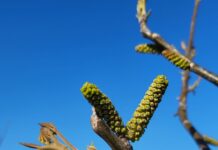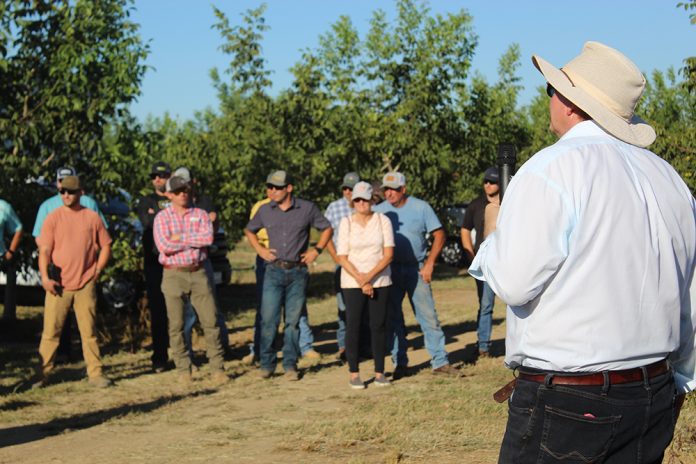
The results of a UC study focusing on nematodes in walnuts were presented recently to the public. UC Riverside Nematologist Dr. Andreas Westphal delivered the findings from the trial to a group of growers, PCAs and other members of the industry at the Escalon, Calif. trial site during an open UC ANR-sponsored meeting on August 17. Research on the orchard trial, which began in summer 2020, has focused on alternatives to current nematode management treatments to prevent nematodes in new orchards following walnuts or other nut crops.
Most currently used rootstocks in walnut production are susceptible to plant-parasitic nematodes, especially to the root lesion nematode (RLN), Pratylenchus vulnus, according to Westphal, who said that as few as one nematode per 250 cc of soil at planting can be damaging to walnuts.
Because of this susceptibility, Westphal says soil sampling when planning and preparing for a new orchard planting is crucial. In recent years, preplant treatments have heavily relied on the use of 1,3-dichloropropene often formulated as Telone. In replant situations, Telone is often co-applied with chloropicrin which has higher activity against other soilborne microbes.
At this walnut replant RLN-infested site, different preplant treatments were applied in August 2020. The whole trial was then planted to ‘Livermore’ on ‘Paradox Hybrid’ seedling rootstock in winter 2021.
The field day allowed attendees to see the treatment scenarios that were tested at the trial site and the various ways they have been applied.
In total, nine different treatment regiments, preplant treatment plus at-plant and post-plant application patterns were illustrated at the research plots. These included: (a) non-treated, (b) Dominus, (c)Velum One, (d) ASD Brassica cover crop, (e) ASD Sudangrass ‘Piper,’ (f) Telone-chloropicrin co-applied, (g) Salibro, (h) ASD Rice bran and (i) ASD Sunnhemp Crotalaria.
In the study, several treatments showed improved growth over the non-treated control, Westphal said. Trees following Telone application presented the strongest vigor, but regulatory changes may limit the feasibility of its use in the future.
“Yes, Telone is still a very good material. The regulatory changes will modify its use pattern creating possibly higher expenses and less efficacy,” he said.
Currently, Telone applications are not without difficulties in fine-textured soils and if soil conditions are too wet. Telone is injected into the soil as a liquid. There, it becomes a gas that then redistributes in the soil matrix. If many of the soil pores are filled with water, movement can be encumbered, and fumigation is liable to have less than optimal efficacy. Regulations scheduled to be in effect on Jan. 1, 2024 call for higher moisture in the soil, deeper injections or covering with totally impermeable film (TIF) tarp.
Westphal cautions to keep in mind that most nematodes are fairly deep in the soil, and when soil was sampled from zero to five feet depths in the study, large populations were often found at great depth.
“Frequently, there are these populations at great soil depths, and we need to be concerned about them when we want to do preplant treatment,” he said.
He also noted it’s extremely important the active ingredients are delivered at the right depths.
“The chemicals tested in this trial, Dominus, Salibro and Velum One, are all poor or non-fumigants, so they need to be administered to the site where the nematodes are in the soil profile,” he said. “That’s why we delivered them by soil drenching.”
Westphal said anaerobic soil disinfestation (ASD) has also shown promise in collaborative work with Dr. Greg Browne and Dr. Dan Kluepfel in other settings. In this process, easily decomposable substrate is incorporated into the soil, which is kept at high soil moisture conditions under tarp for about one month. The developing anaerobic conditions then kill microbes and nematodes in the soil.
Frequently, rice bran is used as substrate for this process. When talking about ASD further, Westphal said the treatment is expensive and might not be applicable in all situations. Logistics may also be challenging when coordinating the different processes necessary for the method.
In the Escalon trial, Westphal’s team grew Sudangrass ‘Piper’, radish, and Sunnhemp cover crops from May 2020 to August 2020.
“The idea was that we produce the biomass for ASD in the field where this is going to be administered,” he said.
Sunnhemp and Sudangrass used for ASD were followed by improved plant growth but surprisingly radish, a popular biofumigant in annual crop production, didn’t work as well as they had expected, tending to incumber tree growth rather than helping it.
“It seemed to be rather damaging to trees when we used the radish material plus some mustard seed meal as substrate for ASD,” Westphal said. “And that seemed to mirror what we saw in almond trials where we use radish as a companion crop being planted very close to the trees.”
The Long Game
The damage caused to walnut trees by nematodes can be fairly nondescriptive. Oftentimes trees seem to not grow quite right, lagging behind others in the same orchard, Westphal explained.
“Many times in an orchard there is quite a lot of variability from tree to tree that shouldn’t be there if the trees are on the same rootstock” he said. “The damage is caused to the plant by the nematode-consuming nutrients that it uses for its own use.”
A not-so-surprising finding from the trial was that walnuts are very sensitive to nematodes, but their sensitivity was exemplified in this study, with nontreated trees showing greater weakness than treated ones, Westphal said.
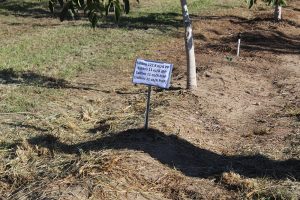
“We have a number of treatments that look better than the non-treated control. Treatments need to also be compared to ‘standard practices’ as the fumigation with Telone and chloropicrin in the mix,” he said. “Evaluating how the treatments fare between the poorest and the most vigorous treatments will be critical to assess their utility.”
As with other UC studies, the research conducted on the nematode trial will feed back into research on other trials. As the team moves forward, Westphal said they planned to see this orchard through to harvest and would continue to monitor test treatments as the trees mature.
“We want to see what the trees are going to do in their sixth or seventh year when, typically, a walnut reaches full productive capacity,” he said.
Westphal works on topics like the nematode issue not only in walnuts but in almonds and grapes as well. He hopes to be able to conduct a similar trial to this one on almonds and is looking for growers who might be willing to collaborate.
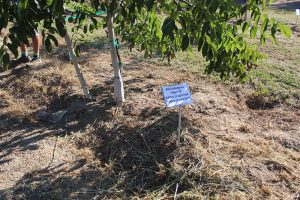
“We are looking for a site where we can do some preplant treatments for almond, which have a slightly different nematode problem than walnuts but, overall, have a very similar challenge,” he said.
The five-acre orchard where the walnut nematode trial is taking place was donated by Robert Longstreth. The site allowed for a larger expanse of their research than the research team has traditionally been afforded at the Kearney Agricultural Research and Extension Center in Parlier, Calif., according to Westphal.
“We are glad that Robert Longstreth is willing to help us so much and allowing us to use this site so that we could use treatments on a little bit larger of a scale than we can do at our research center, where we test more, different treatments, but not at a larger scale like we can do here.”
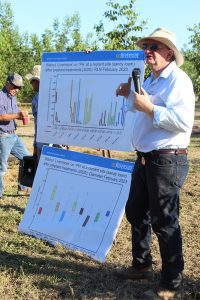
Looking at New Solutions
Rachelle Antineti, who offers strategic business planning for agribusiness professionals and also works with local community colleges to build internship and apprenticeship programs, said she attended the field day for a number of reasons.
A significant portion of Antineti’s consulting clients include farm management companies and independent consultants, and she said several new companies have recently solicited her assistance in launching biological-based products.
“My primary objective was to gain insights into the current research outcomes and to familiarize myself with the strategic directions the University of California is pursuing in the domain of alternative fumigation methodologies,” she said.
Antineti said her key takeaway from the field day was about the persistent prominence of Telone as the industry benchmark for effective control measures.
“Conversations I engaged in with PCAs during the event indicated a unanimous agreement that, given its continued availability, investment in preplant fumigation remains advisable,” she said.
She added there was also a considerable amount of dialogue at the field day regarding ongoing research initiatives and their integration of biological products as potential alternatives to the prevailing industry standard.
“These preplant and post-plant solutions have exhibited some degree of success in the market, prompting my eagerness to deepen my understanding of their attributes,” Antineti said. “



